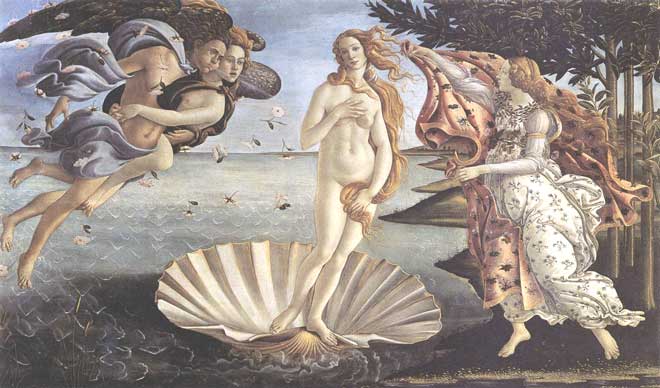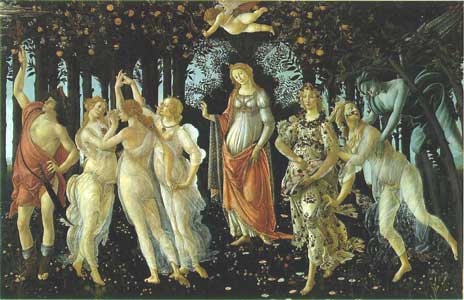|
|
Alessandro di Mariano Filipepi, better known as Sandro Botticelli (Florence March 1, 1445 – May 17, 1510) was an Italian painter of the Florentine school during the Early Renaissance (Quattrocento). Less than a hundred years later, this movement, under the patronage of Lorenzo de' Medici, was characterized by Giorgio Vasari as a "golden age", a thought, suitably enough, he expressed at the head of his Vita of Botticelli.
The Birth of Venus: a revived Venus Pudica for a new view of pagan Antiquity (Uffizi, Florence). One of the first full-length female nude in the Renaissance Born in Florence in the working-class rione of Ognissanti, Botticelli was first apprenticed to a goldsmith, then, following the boy's wishes, his doting father sent him to Fra Filippo Lippi who was at work frescoing the Convent of the Carmine. Lippo Lippi's synthesis of the new control of three-dimensional forms, tender expressiveness in face and gesture, and decorative details inherited from the late Gothic style were the strongest influences on Botticelli. A different influence was the new scuptural monumentality of the Pollaiuolo brothers, who were doing a series of Virtues for the Tribunale or meeting hall of the Mercanzia, a cloth-merchants' confraternity, and Botticello contributed to the set the Fortitude, dated 1470 in the Uffizi Gallery . He was an apprentice too of Andrea del Verrocchio, where Leonardo da Vinci worked beside him, but he made his name in his local Church of Ognisanti, with a Saint Augustine that successfully competed as a pendant with Domenico Ghirlandaio's Jerome on the other side "the head of the saint being expressive of profound thought and quick subtlety" (Vasari) In 1470 he opened his own independent studio. Lorenzo de' Medici was quick to employ his talent. Botticelli made consistent use of the circular tondo form and did many beautiful female nudes, according to Vasari. The Birth of Venus was at the Medici villa of Castello.
Botticelli's Venus graces the first of the Italian euro coins (2002) He was influenced in his art by Fra Filippo Lippi and Antonio Pollaiuolo. The repeated contacts with the Medici family were undoubtedly useful for granting him political protection and creating conditions ideal for his production of several masterpieces. Sandro was intensely religious. In later life, he was one of Savonarola's followers and burned his own paintings on pagan themes in the notorious "Bonfire of the Vanities". Earlier, Botticelli had painted an Assumption of the Virgin for Matteo Palmieri in a chapel at San Pietro Maggiore in which, it was rumored, both the patron who dictated the iconic scheme and the painter who painted it, were guilty of unidentified heresy, a delicate requirement in such a subject. The heretical notions seem to be gnostic in character: "By the side door of San Piero Maggiore he did a panel for Matteo Palmieri, with a large number of figures representing the Assumption of Our Lady with zones of patriarchs, prophets, apostles, evangelists, martyrs, confessors, doctors, virgins, and the orders of angels, the whole from a design given to him by Matteo, who was a worthy and learned man. He executed this work with the greatest mastery and diligence, introducing the portraits of Matteo and his wife on their knees. But although the great beauty of this work could find no other fault with it, said that Matteo and Sandro were guilty of grave heresy. Whether this be true or not, I cannot say." (Vasari) This is a common misconception based on a mistake by Vasari. The painting referred to here, now in the National Gallery in London, is by the artist Botticini. Vasari confused their similar sounding names.
 |
|
|||||||||||||||||


